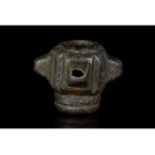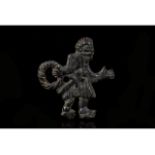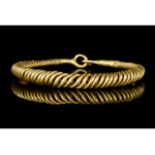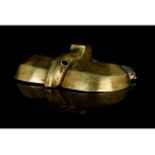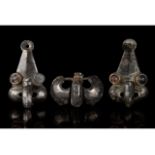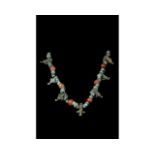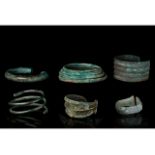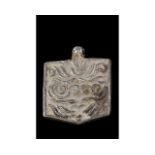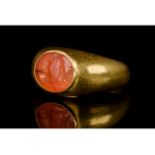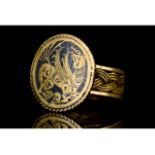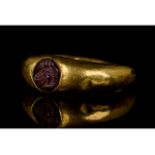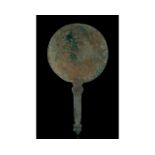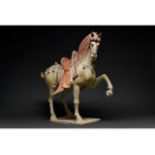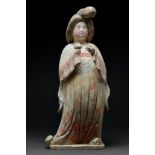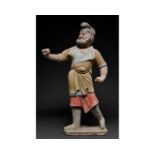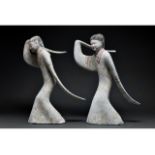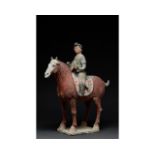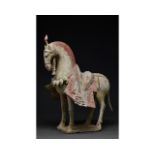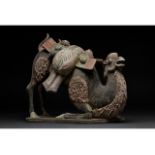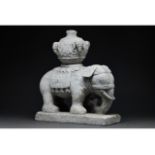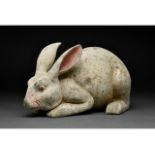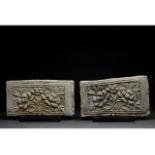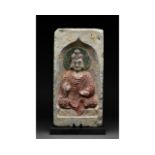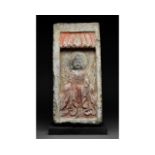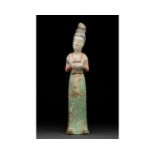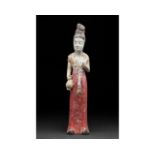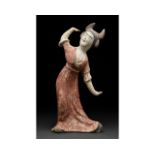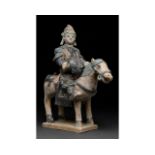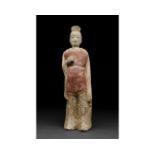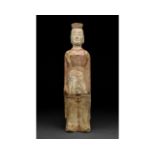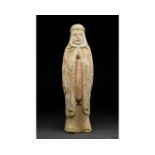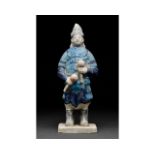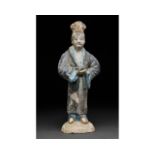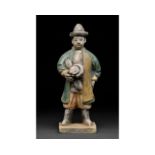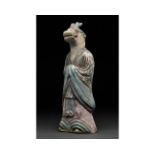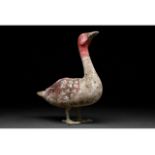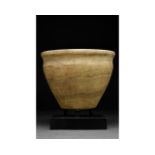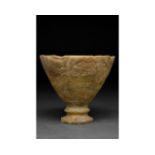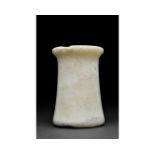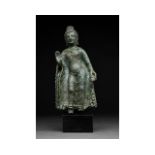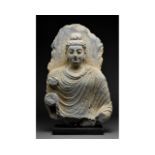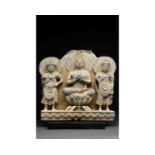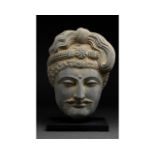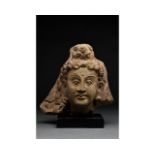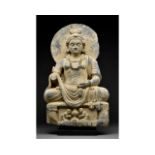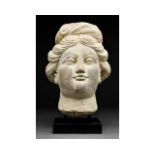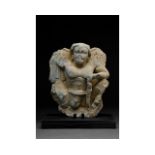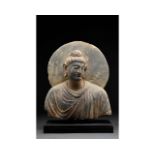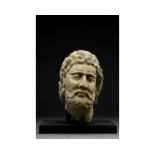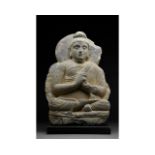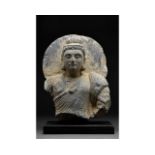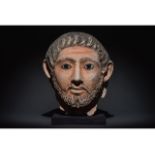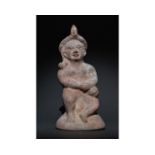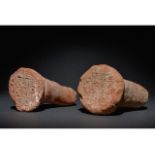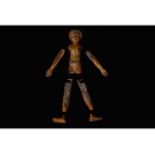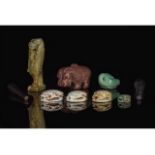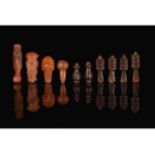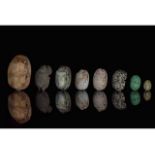Refine your search
Estimate
Category
- Arms, Armour & Militaria (102)
- Jewellery (80)
- Greek, Roman, Egyptian & Other Antiquities (54)
- Sculpture (35)
- Chinese Works of Art (25)
- Collectables (19)
- Glassware (15)
- Books & Periodicals (14)
- Scientific Instruments (14)
- Ceramics (11)
- Models, Toys, Dolls & Games (7)
- Taxidermy & Natural History (6)
- Coins (4)
- Vintage Fashion (4)
- Stamps (3)
- Metalware (2)
- Textiles (2)
- Bank notes (1)
- Furniture (1)
- Kitchenalia (1)
- Oil, Acrylic paintings & Mixed Media (1)
- Russian Works of Art (1)
- Salvage & Architectural Antiques (1)
- Silver & Silver-plated items (1)
- List
- Grid
A subscription to the Price Guide is required to view results for auctions ten days or older. Click here for more information
MEDIEVAL BRONZE MACE HEAD
Ca. 1200-1400 AD. Medieval Western Europe. A bronze mace head with rounded pyramidal projections, vertical flanges and a small circular shaft hole...
Ca. 700-900 AD. Viking. A rare bronze figure depicting the legendary hero Sigurd who famously slew the dragon Fáfnir. Sigurd, in a military outfit...
Ca. 100-200 AD. Roman. A rare gold bracelet made of thick, twisted gold wires with a hook clasp. Excellent condition. Jewels were particularly imp...
Ca. 500-700 AD. Western Europe, Merovingian, Migration Period. A beautiful gilded silver belt buckle with inset garnets. Excellent condition. At t...
MEROVINGIAN SILVER BELT SET
Ca. 500-700 AD. Western Europe, Merovingian, Migration Period. A beautiful set of silver belt fittings with inset garnets; such fittings were usua...
Ca. 800-600 BC. Bronze Age. A beautiful bronze necklace comprising numerous stylised mace-head pendant amulets and stone beads in a red palette. G...
Ca. 800-600 BC. Bronze Age. Europe. A collection of bronze bracelets, each with an attractive green patina. Each bracelet is made of a single rod ...
Ca. 900-1100 AD. Viking. A beautiful square silver amulet with stylised decoration and an integral adorned suspension loop. Pendants and amulets o...
Ca. 100-300 AD. Roman. A wearable gold ring featuring a circular band, flared shoulders, and large oval bezel embellished with a finely incised in...
Ca. 1100-1300 AD. Medieval Western Europe. A stunning gold ring with a circular band decorated with three interlaced gold bands. The applied circu...
Ca. 100-300 AD. Roman. A beautiful gold ring featuring a circular band, flared shoulders, and a large oval bezel set with a garnet gemstone featur...
Ca. 400 BC. Classical period. A graceful cast bronze mirror comprising a slightly concave thin disc with a short lip that would have once held a h...
Ca. 618-907 AD. Chinese Tang Dynasty. A beautiful pottery figure of a prancing horse. The spirited horse is shown with left foreleg raised, red ma...
Ca. 618–907 AD. Chinese Tang Dynasty. The elegant figure stands on a flat, shaped base, with the head turned slightly to the side and her hands he...
Ca. 618-907 AD. Chinese Tang Dynasty. This lead-glazed earthenware figurine shows a standing male wearing an ochre, red and green glazed tunic tie...
Ca. 202 BC-220 AD. Han Dynasty. Two large grey earthenware figures of dancers. The elegant clothing comprises flowing, long-sleeved robes decorate...
Ca. 618-907 AD. Chinese Tang Dynasty. An extremely fine moulded terracotta figurine of a female court musician shown on horseback while playing a ...
Ca. 386-534 AD. Northern Wei Dynasty. A finely hollow-moulded terracotta horse statuette. The horse is finely modeled with a graceful, arched neck...
Ca. 618-907 AD. Chinese Tang Dynasty. A large ceramic figurine of a Bactrian camel, also known as a Mongolian camel. The beast features a black pe...
Ca. 1368-1644 AD. Ming Dynasty (or later). A beautiful marble elephant shown standing foursquare on a rectangular base, wearing a halter and a che...
Ca. 202 BC-220 AD. Han dynasty. A hollow-formed terracotta rabbit figurine with a black pelt and coral-pink pigmentation on the nose and in the in...
Ca. 202 BC-220 AD. Han dynasty. A hollow-formed terracotta rabbit figurine with a white pelt and coral-pink pigmentation on the nose and in the in...
Ca. 960-1279 AD. Song Dynasty. A fine pair of terracotta bricks decorated with high-relief floral motifs. The Song Dynasty, which ruled most of Ch...
Ca. 386-534/535 AD. Northern Wei Dynasty. A terracotta tile featuring a beautiful depiction of a seated Buddha wearing garments whose red pigment ...
Ca. 386-534/535 AD. Northern Wei Dynasty. A terracotta tile featuring a beautiful depiction of a seated Buddha wearing garments whose red pigment ...
Ca. 618-907. Tang Dynasty. A finely modelled terracotta figure of a female court lady. She is depicted standing and attentive, wearing a long dres...
Ca. 618-907. Tang Dynasty. A finely modelled terracotta figure of a female court lady. She is depicted standing and attentive, wearing a long dres...
Ca. 618-907. Tang Dynasty. A delicate terracotta female dancer figure wearing a long flowing, deep orange gown with short sleeves and a waist sash...
Ca. 1368-1644 AD. Ming Dynasty. An extremely fine moulded terracotta figure of a male rider shown on horseback. The cream-coloured horse is depict...
Ca. 500 AD. Chinese Northern Wei Dynasty. A carefully crafted male attendant figure dressed in a red tunic and cream-coloured trousers; a cream sa...
Ca. 500 AD. Chinese Northern Wei Dynasty. A carefully crafted male attendant figure dressed in a pinkish-cream tunic and dark cream-coloured trous...
Ca. 550-577 AD. Northern Qi Dynasty. A male terracotta figure depicting a soldier with the sleeves of his cream-coloured and red garments covering...
Ca. 1368-1644 AD. Ming Dynasty. A beautifully glazed terracotta standing warrior wearing a long draping gown of rich cobalt and turquoise blue col...
Ca. 1368-1644 AD. Ming Dynasty. An elaborate male servant figure in court dress or shenyi consisting of a long waistcoat tied at the waist and lon...
Ca. 1368-1644 AD. Ming Dynasty. An elaborate male figure with beautifully glazed pigment. The man is standing with his feet apart and dressed in o...
Ca. 1368-1644 AD. Ming Dynasty. An elaborate terracotta zodiac figure in a court dress or shenyi consisting of a long waistcoat tied at the waist ...
Ca. 202 BC-220 AD. Han dynasty. A beautiful and rare Chinese Han dynasty pottery goose with bronze legs. The goose is standing on its detailed bro...
BACTRIAN ALABASTER VESSEL
Ca. 3100-2500 BC. Bactrian. A fine Bactrian alabaster vessel, featuring a flat foot, a slightly bulbous body with the sides slightly flaring outwa...
BACTRIAN ALABASTER VESSEL
Ca. 3100-2500 BC. Bactrian. A fine conical Bactrian alabaster vessel, standing on a narrow flared foot. It has a beautiful cream colour, with grey...
BACTRIAN ALABASTER COLUMN IDOL
Ca. 3100-2500 BC. Bactrian. A beautiful example of a column idol (sometimes called a pillar idol), hand-carved from cream coloured Alabaster. The ...
GANDHARA BRONZE FIGURE OF BUDDHA
Ca. 400-500 AD. Gandharan. The Buddha stands with his right hand raised in abhayamudra and his left clutches the folds of his voluminous sanghati ...
GANDHARA SCHIST TORSO OF BUDDHA
Ca. 100-300 AD. Gandharan. A schist stone torso of a Buddha. He is depicted wearing a flowing robe (samghati) and a topknot (ushnisha), with losse...
Ca. 100-300 AD. Gandharan. A schist stone panel of a Buddha flanked by two Bodhisattvas. Each has a large circular halo behind his head. The centr...
Ca. 100-300 AD. Gandharan. A schist stone head of a Buddha. He is depicted with wavey hair gathered up in a topknot above a headband. His face cha...
GANDHARA SCHIST STONE HEAD OF BUDDHA
Ca. 100-300 AD. Gandharan. A schist stone head of a Buddha. He is depicted with curly ringlets of hair gathered up in a topknot (ushnisha). He has...
Ca. 100-300 AD. Gandharan. A schist stone statue of a Buddha. He is depicted wearing a flowing robe (samghati) draped elegantly around his left sh...
Ca. 150-300 AD. Gandharan. A schist stone head of a woman. She is depicted with wavey hair tied up in a bundle, soft eyes and full lips, and pump ...
Ca. 100-300 AD. Gandharan. A schist stone statue of Atlas. He is shown with his characteristic iconography within Gandharan art, appearing as a wi...
Ca. 100-300 AD. Gandharan. A schist stone torso of a Buddha. He is depicted wearing a flowing robe and a topknot (ushnisha). He is characterised b...
Ca. 300-100 BC. Graeco-Bactrian. A marble head of a man with a thick beard, hanging down in broad locks along the cheeks. His face is carefully mo...
Ca. 100-300 AD. Gandharan. A schist stone depicting a seated Buddha in a lotus pose - the right leg folded in first and the left leg on top. The B...
Ca. 100â-00 AD. Gandharan. A schist stone torso of a Buddha. He is depicted wearing a flowing robe (samghati) and a topknot (ushnisha), with losse...
Ca. 323 BC-395 AD. Graeco-Roman Period. A Greco-Egyptian ceramic head of a man. The piece is stunningly life-like. The man depicted has wavy locks...
Ca. 100-200 AD. Roman Period. A terracotta figure of the young god Harpocrates, covered with traces of white pigment. He is represented nude, infa...
Ca. 1360 BC. 18th dynasty, reign of Amenhotep III. A pair of orange-brown Nile silt funerary cones. They are formed of undecorated, roughly conica...
EGYPTIAN BONE DOLL
Ca. 100-200 AD. Roman Period. An articulated doll made of dark bone. The doll is formed of seven separate parts, allowing movement, and they would...
EGYPTIAN STATUETTE OF SEKHMET
Ca. 664-332 BC. Late Period. A statuette of Sekhmet in pale blue-glazed faience. The goddess is shown enthroned, seated upon an undecorated block ...
Ca. 1520-30 BC. New Kingdom - Ptolemaic Dynasty. A collection of scarabs, statuettes, and pestles. These include a small yellow statuette of Tawer...
Ca. 1520-30 BC. New Kingdom – Ptolemaic Dynasty. A collection of ten amulets. Four of them are made of orange-red carnelian, and the other six a...
EGYPTIAN GROUP OF EIGHT SCARABS
Ca. 1674-30 BC. Second Intermediate Period - Ptolemaic Dynasty. A group of eight scarab amulets. The collection is comprised of various stone type...

